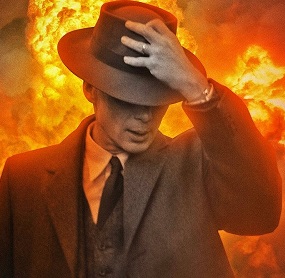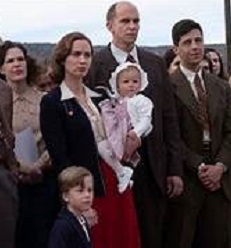Oppenheimer
 In 1942, American physicist J. Robert Oppenheimer was recruited to lead the Manhattan Project, a secretive government undertaking to develop an atomic bomb. Being Jewish, Oppenheimer maintained a fear that the Nazis would develop the first such bomb and use it against humanity. Oppenheimer and U.S. Army General Lesley Groves assembled a crack team of some of the top theoretical physicists of the day, brought them to a laboratory in Los Alamos, New Mexico, and successfully test-fired a nuclear bomb during the summer of 1945 (after the surrender of the Nazis but before the surrender of the Japanese).
In 1942, American physicist J. Robert Oppenheimer was recruited to lead the Manhattan Project, a secretive government undertaking to develop an atomic bomb. Being Jewish, Oppenheimer maintained a fear that the Nazis would develop the first such bomb and use it against humanity. Oppenheimer and U.S. Army General Lesley Groves assembled a crack team of some of the top theoretical physicists of the day, brought them to a laboratory in Los Alamos, New Mexico, and successfully test-fired a nuclear bomb during the summer of 1945 (after the surrender of the Nazis but before the surrender of the Japanese).
Dropping of the bombs
The rest of the story we know. President Harry Truman ordered the dropping of a first, and then a second, atomic bomb on the Japanese cities of Hiroshima and Nagasaki, resulting in their surrender. What most of us don’t know is the story of Oppenheimer himself. What made him tick? What concerns did he possess regarding the invention of a weapon which had the potential to destroy the world? Or at least generate an arms race between the United States and the Soviet Union?
Interesting choice
Christopher Nolan’s latest effort, “Oppenheimer,” seeks to shed some light on one of the greatest scientists of the 20th century, and perhaps of all time. This would seem an interesting choice for Nolan, a director whom I’ve faulted in the past for providing almost too much spectacle at the expense of story. It’s not that he hasn’t attempted historical accounts. His 2017 film “Dunkirk” intertwined several stories surrounding the WWII battle between British and Nazi forces. Unfortunately, even here Nolan leaned too heavily on the extravaganza of the air war, and (in my opinion) shortchanged his most interesting story thread.
In service to the story
This time, the pageantry of spectacle is ever-present, just as we expect, but here the special effects are in service of the story, rather than supplanting it. For Nolan fans, “Oppenheimer” easily meets (and perhaps exceeds) expectations – from the powerful Ludwig Goransson score building during crucial moments, to the dramatic demonstration of the bomb, to even the occasional dream sequence as Dr. Oppenheimer wrestles with his convictions regarding the project. In fact, “Oppenheimer” is even available in an IMAX format in certain cities (including Indianapolis).
But this one has a story too. Adapted by Nolan from Kai Bird and Martin J. Sherwin’s 2005 biography “American Prometheus,” “Oppenheimer” almost suffers from too much story. Clocking in at a long three hours, Nolan could have cut several early scenes in which Oppenheimer, as a young doctoral student, meets various scientists who encourage him in his career. Also expendable is a story thread regarding Oppenheimer’s extramarital affair with a physicist played by Florence Pugh. The narrative implies several times that Dr. Oppenheimer is a philanderer; I think that’s sufficient.
 The cast
The cast
As Oppenheimer, Irish actor Cillian Murphy (who also appeared in Nolan’s “Dunkirk” and “Interstellar”) turns in the best performance of his career. He embodies his character so completely and sufficiently we forget we’re watching Murphy. Emily Blunt is also in top form as Oppenheimer’s wife Kitty, a biologist and former member of the Communist Part of America.
Robert Downey Jr.
But here’s what I find most amazing about the cast: Robert Downey Jr., who had quite a career going prior to his 2000-2003 drug conviction and rehab, turns in his best performance ever as U.S. Atomic Energy Commission Chairman Lewis Strauss, a man who harbors a grudge against Oppenheimer for suggesting the United States quickly engage in nuclear arms talks with the Soviets. Strauss’ frustration with Oppenheimer drives him to borderline madness. And Downey milks the richness of the character in the same way F. Murray Abraham’s Salieri was driven to hysteria over his jealously of the more talented Mozart in “Amadeus.” At the very least, this performance should garner Downey a supporting actor nod.
Other cast members
The interplay between Oppenheimer and General Groves (another outstanding turn by Matt Damon) is also rich. These are two very intelligent men, and their conversation features enough one-upmanship to satisfy the most discerning viewer.
Nolan even coaxes excellent acting achievements from his bit players. British actor Gary Oldman is almost invisible as President Truman. And Tom Conti, who hasn’t done anything in a while, offers fine work as Albert Einstein.
Flashback technique works
I should mention that most of “Oppenheimer” is told in flashback – a filmmaking technique very difficult to pull off, as it often interferes with the logical flow of the story. But here, not only does the flashback approach work flawlessly, but it enhances the story. Nolan juxtaposes the Manhattan Project narrative with a 1954 Atomic Energy Commission hearing designed to strip Oppenheimer of his security clearance based on his alleged ties to the Communist Party. In this case, the hearing is used to guide us through the earlier sequence. When I say it works flawlessly, I believe the sense of urgency would be removed from the Manhattan Project plot without our knowledge of the proceedings of a decade later. This is one of the rare times when the dual storyline approach strengthens the film.
Best so far
Now I know it’s only summer, but “Oppenheimer” is the kind of achievement we’ll be talking about come Oscar season. Nolan and his film each deserve nominations, not to mention Nolan’s adapted screenplay. Murphy, Downey, and Blunt should receive acting selections as well. For my money, “Oppenheimer” is the best film so far this year.
Andy Ray‘s reviews also appear on https://youarecurrent.com/category/nightandday/film-reviews/.